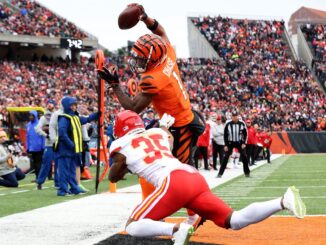
Week 1 threw up plenty of surprises, but perhaps none of them were bigger that what we saw in Cleveland. The Browns held a potent Bengals offense to just three points, easily the lowest mark of the Joe Burrow era.
Burrow himself managed to complete just 45.2% of his passes and throw for a paltry 85 yards all game. He had just one completion of more than 10 yards all game. So how did it all happen? What did the Browns do to cause this offense so many problems?
It all starts with their defensive front. I’ve outlined three key techniques that the Browns used to bamboozle Burrow and the Bengals. Let’s get to the tape.
Blitzes. Lots of blitzes
The Browns’ pass rush plan was all about creating advantageous one-on-one matchups. One way they did that was to blitz – a lot. There aren’t many defensive coordinators willing to risk their reputation by blitzing Joe Burrow. After all, he’s one of the smartest quarterbacks in the game and knows how to make you pay.
Jim Schwartz is unlike a lot of other defensive coordinators though. The Browns blitzed Burrow on a whopping 39.4% of dropbacks in Week 1. For context, over the past two seasons, defenses have blitzed Burrow on just 26.4% of his dropbacks. He was blitzed at the fourth lowest rate in the NFL last season.
No play better encapsulates this approach than this blitz. This actually came after Burrow had been pulled in the fourth quarter, but the fact the Browns were still throwing the kitchen sink at that point is testament to their aggression.
They present a simple four-man front but this is actually a fire zone coverage. At the snap they send a linebacker and the overhang defender on a blitz, whilst dropping Za’Darius Smith back into coverage.
This overloads the left hand side of the offensive line, with the aim of getting a free runner. Things are made even worse for the Bengals by the fact that they are in a full slide protection, with their entire offensive line sliding to their right. The play ends with the Myles Garrett drilling backup quarterback Jake Browning as his throw falls incomplete.
This next play was another great example of Jim Schwartz’s creativity. The Browns are effectively in a five-man front, but are presenting a very exotic look. Linebacker Jeremiah Owusu-Koramoah lines up on the right side as a wide-9.
Meanwhile Myles Garrett is effectively playing as a stand-up rusher from an inside alignment (known as a “spinner” – more on that later).
The Browns end up sending all five, whilst also bringing linebacker Sione Takitaki (#44) on a blitz. This keeps the running back in pass protection and leaves the Browns with one-on-ones across the board. Joe Burrow quickly faces pressure and throws the ball away.
Pairing their edges
Another way that the Browns were able to generate favourable matchups was to line up with two edge rushers on one side of the formation.
On the majority of the Bengals’ third downs, the Browns were playing with three edge rushers (generally Myles Garrett, Za’Darius Smith, and Ogbonnia Okoronkwo). All three were moved across the front, keeping Cincinnati guessing and creating plenty of favourable matchups.
On this play, the Browns line up with Garrett and Smith over the left tackle and left guard respectively. The way they align the rest of their front almost guarantees one-on-ones for both of them. With Dalvin Tomlinson playing as a 0-tech (head up over the center), the center is occupied and isn’t able to provide support.
It works exactly as planned. Both Garrett and Smith get one-on-ones. When you’re leaving an exceptional pass rusher like Za’Darius Smith in a one-on-one battle with a guard it is bound to cause problems, and he quickly walks him back into the pocket. Burrow throws it short of the sticks and ends the Bengals’ drive.
The Browns kept doing this whilst subtly changing their looks. On this play they basically force the Bengals’ offensive line to pick their poison. Smith and Okoronkwo line up together on the right side of the line this time. If the center slides to the right, you’ve given Myles Garrett a one-on-one on the other side. If he slides left, Smith has another one-on-one with a guard.
Neither of those situations are in any way appealing, but the Bengals settle for the former. Garrett walks back left tackle Orlando Brown, but this time it is actually Dalvin Tomlinson who generates the pressure by bulldozing the left guard. Burrow escapes and completes the pass, but once again it is short of the sticks.
As the game progressed the Bengals realised they needed to do something differently. They certainly got better at handling it, but their solution came at a cost.
This next play came in the fourth quarter on a 3rd and 10. The Bengals’ decided to give their offensive line extra help, by using their running back and tight end to provide chip help, effectively blocking before getting out into the route. You can see that here, with the tight end helping with Okoronkwo and the running back helping with Garrett.
That allows the center and right guard to double Za’Darius Smith, leaving just one pure man-to-man matchup. The problem with this was that whilst it slowed the pass rush, it also prevented the tight end and running back from getting out into their routes quickly.
With seven offensive players involved in the protection, that meant that there were two underneath targets that Burrow didn’t have at his disposal quickly. It also meant that the Browns then had seven defenders to cover the Bengals’ three other receiving threats. That’s the kind of mismatch defensive coordinators love to create.
The spinner
Last but not least was the Browns’ use of the “spinner”. I mentioned earlier how this involves bringing an edge rusher inside to play as a stand-up rusher from an inside alignment.
This is a technique that we’ve seen other teams use before. The Vikings did this quite a lot last season with Za’Darius Smith. The Cowboys also love to use this technique with their bevy of pass rushing talent.
You can see the havoc it causes on this play from the Bengals’ first drive. The Browns come out in a 5-0 front, with a defender over each of the offensive linemen. Myles Garrett lines up over the center. The Browns have two other edges on the field, with Za’Darius Smith and Ogbonnia Okoronkwo.
This effectively forces the Bengals into what is known as man, or “BOB” protection (big on big), which tasks each offensive lineman with blocking the defender in front of him. The problem? Well, the problem is you are asking your center to hold up in a one-on-one against Myles Garrett. That’s never going to work, and it shows here. Garrett creates instant pressure, forcing Burrow to climb the pocket into the waiting arms of the Browns defense.
The Browns brought the same exact pressure in the third quarter. This time the Bengals tried something different in response. Instead of BOB protection, they called a full slide, with the entire offensive line sliding right. The idea here is that it gives added support to stop Garrett and co collapsing the pocket from the inside.
So what’s the problem with that approach? As you can see from the tape, it means you are asking your running back to block an edge rusher one-on-one. That’s rarely going to end well. Whilst Chris Evans slows Okoronkwo down, Burrow is still forced to get the ball out quickly and it falls incomplete.
The big question many will have is what this means for the Bengals. Will other teams be able to copy this approach? Have the Browns found a major weakness in the Bengals’ offense that other defenses can exploit each week?
I think the answer to both of these questions is no (Bengals fans everywhere will be breathing a sigh of relief at this point). For one, this worked because the Browns can call upon three quality edge rushers. There really aren’t many teams who have that level of talent on their defensive line. There are even fewer who can lay claim to a truly elite edge like Myles Garrett.
I think what this actually showed is that this Browns defense might finally be ready to live up to the incredible talent they boast on paper. Special credit has to go to Jim Schwartz for calling an outstanding game in his debut as Browns defensive coordinator. They look like they will be an exciting unit to watch each and every week.


